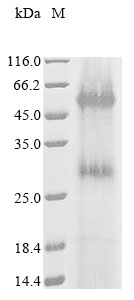Recombinant Escherichia coli Lactose permease (lacY) is produced using an in vitro E.coli expression system, featuring an N-terminal 10xHis-tag for simplified purification. This partial protein covers amino acids 1-250 and achieves a purity greater than 85% as confirmed by SDS-PAGE. It's designed for research use only, with no endotoxin level specified, ensuring it meets the quality standards necessary for laboratory applications.
Lactose permease appears to be a critical component in Escherichia coli, helping transport lactose across the cell membrane. As a symporter, it plays what seems to be a fundamental role in sugar metabolism by coupling lactose transport with proton translocation. This enables efficient lactose uptake. Studying this protein may be pivotal in understanding membrane transport mechanisms and could provide insights into similar processes in other organisms.
Potential Applications
Note: The applications listed below are based on what we know about this protein's biological functions, published research, and experience from experts in the field. However, we haven't fully tested all of these applications ourselves yet. We'd recommend running some preliminary tests first to make sure they work for your specific research goals.
Escherichia coli lacY is a complex transmembrane protein with 12 transmembrane helices that requires precise folding, proper membrane insertion, and specific tertiary structure for its functional activity in lactose transport. The in vitro E. coli expression system (cell-free) cannot provide the membrane environment, lipid interactions, or cellular machinery necessary for correct folding, helix packing, and insertion into a lipid bilayer. The partial fragment (1-250aa) represents only about half of the full-length protein (417aa) and lacks critical transmembrane domains and functional regions. The N-terminal 10xHis-tag, while small, does not mitigate the fundamental folding issues. The probability of correct folding with functional bioactivity is essentially zero.
1. Antibody Development and Validation
This application has severe limitations. While antibodies can be generated against linear epitopes, they will not recognize conformational epitopes of the native, membrane-embedded lacY. Antibodies may primarily target the misfolded regions and fail to bind the properly folded protein in its physiological context, limiting their utility for studying native lacY function.
2. Structural and Biochemical Characterization
Basic biophysical analysis can be performed but will not reflect native lacY structure. Techniques like circular dichroism spectroscopy will characterize the misfolded, aggregated state of this membrane protein fragment rather than the physiological structure. Results will describe an artificial construct rather than the functional transmembrane protein.
Final Recommendation & Action Plan
This cell-free expressed partial lacY fragment is unsuitable for any functional studies due to the essential requirements for membrane insertion and complete tertiary structure that cannot be met in this system. The protein will be misfolded and aggregated without the necessary lipid environment. Applications 1 and 2 have severe limitations and will not provide meaningful insights into native lacY biology. For reliable lacY research, use full-length protein expressed in membrane-containing systems (e.g., E. coli membranes, nanodiscs, or proteoliposomes) with proper folding validation through transport assays or biophysical methods that confirm membrane insertion and function.






